Video Lecture
Theory For Notes Making
Lorem ipsum dolor sit amet, consectetur adipiscing elit. Ut elit tellus, luctus nec ullamcorper mattis, pulvinar dapibus leo.
Objective Assignment
Q.1
A ray of light falls normally on a refracting face of a prism of refractive index 1.5. If the ray just fails to emerge from the prism. Then the angle of prism is

(a) {{\sin }^{{-1}}}\left( {\frac{2}{3}} \right)
(b) {{\cos }^{{-1}}}\left( {\frac{2}{3}} \right)
(c) {{\sin }^{{-1}}}\left( {\frac{1}{2}} \right)
(d) {{\sin }^{{-1}}}\left( {\frac{1}{2}} \right)
Ans. (a)
Q.2
A glass prism of refractive index 1.5 is immersed in water (m = 4/3). A light beam incident normally on the face AB is totally reflected to reach the face BC, if
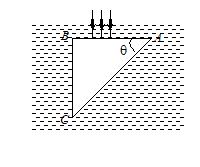
(a) \sin \theta \ge \frac{8}{9}
(b) \sin \theta \le \frac{2}{3}
(c) \sin \theta =\frac{4}{5}
(d) \frac{2}{3}<\sin \theta <\frac{8}{9}
Ans. (a)
Q.3
Light is incident normally on face AB of a prism as shown in figure. A liquid of refractive index m is placed on face AC of the prism. The prism is made of glass of refractive index 3/2. The limits of m for which total internal reflection cannot takes place on face AC is

(a) \frac{{3\sqrt{3}}}{4}> m > \frac{{3\sqrt{3}}}{4}
(b) \mu <\frac{{3\sqrt{3}}}{4}
(c) \mu >\sqrt{3}
(d) \mu <\frac{{\sqrt{3}}}{2}
Ans. (b)
Q.4
A ray of light falls on a prism ABC (AB = BC) and travels as shown in figure. The refractive index of the prism material should be greater than

(a) 4/3
(b) \sqrt{2}
(c) 1.5
(d) \sqrt{3}
Ans. (b)
Q.5
We have two equilateral prisms A and B. They are made of materials having refractive index 1.5 and 1.6. For minimum deviation, incident angle will be
(a) small for prism A
(b) small for prism B
(c) equal for both the prisms
(d) can’t be predicted
Ans. (a)
Q.6
A light ray is incident upon a prism in minimum deviation position and suffers a deviation of 34°. If the shaded half of the prism is knocked off, the ray will
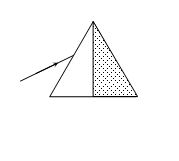
(a) Suffer a deviation of 34°
(b) Suffer a deviation of 68°
(c) Suffer a deviation of 17°
(d) Not come out of the prism
Ans. (c)
Q.7
The light ray is incident at angle of 60° on a prism of angle 45°. When the light ray falls on the other surface at 90°, the refractive index of the material of prism m and the angle of deviation d are given by
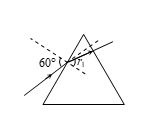
(a) \mu =\sqrt{{\frac{3}{2}}},\,\,\delta =30{}^\circ
(b) \mu =1.5,\,\,\delta =15{}^\circ
(c) \mu =\frac{{\sqrt{3}}}{2},\,\,\delta =30{}^\circ
(d) \mu =\sqrt{{\frac{3}{2}}},\,\delta =15{}^\circ
Ans. (d)
Q.8
For a material, the refractive indices for red, violet and yellow colour light are respectively 1.52, 1.64 and 1.60. The dispersive power of the material is
(a) 2 (b) 0.45 (c) 0.2 (d) 0.045
Ans. (c)
Q.9
A prism (m = 1.5) has a refracting angle of 30°. The deviation of a monochromatic ray incident normally on its one surface will be (sin48°36¢ = 0.75)
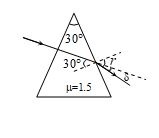
(a) 18°36¢ (b) 22°38¢ (c) 18° (d) 22°1
Ans. (a)
Subjective Assignment
Q.1
Write the relationship between angle of incidence ‘i’, angle of prism ‘A’ and angle of minimum deviation for a triangular prism.
Q.2
(i) Out of blue and red light which is deviated more by a prism ? Give reason.
(ii) Give the formula that can be used to determine refractive index of material of a prism in minimum deviation condition.
Q.3
A ray of light, incident on an equilateral glass prism \displaystyle \left( {{{\mu }_{g}}=\,\sqrt{3}} \right) moves parallel to the base line of the prism inside it. Find the angle of incidence for this ray.
Q.4
A ray of light passes through an equilateral prism in such a way that the angle of incidence is equal to the angle of emergence and each of these angles is ¾ times the angle of the prism. Determine (i) the angle of deviation and (ii) the refractive index of the prism
Q.5
A prism is made of glass of unknown refractive index. A parallel beam of light is incident on a face of the prism. The angle of minimum deviation is measured to be 40°. What is the refractive index of the material of the prism? The refracting angle of the prism is 60°. If the prism is placed in water (refractive index 1.33), predict the new angle of minimum deviation of a parallel beam of light.
Q.6
When a ray of light passes through a triangular glass prism, find out the relation for the total deviation, , in terms of the angle of incidence io, and angle of emergence e. Plot a graph showing the variation of angle of deviation with the angle of incidence and obtain the condition for the angle of minimum deviation.
Q.7
A ray of light is incident on one face of a glass prism and emerges out from the other face. Trace the path of the ray and derive an expression for refractive index of the glass prism.
Q.8
You are given prisms made of crown glass and flint glass with a wide variety of angles. Suggest a combination of prisms which will
(a) deviate a pencil of white light without much dispersion,
(b) disperse (and displace) a pencil of white light without much deviation.
9.
Three light rays red (R), green (G) and Blue (B) are incident on a right angled prism ‘abc’ at face ‘ab’. The refractive indices of the material of the prism for red, green and blue wavelengths are 1.39, 1.44 and 1.47 respectively. Out of the three which colour ray will emerge out of face ‘ac’ ? Justify your answer. Trace the path of these rays after passing through face ‘ab’.
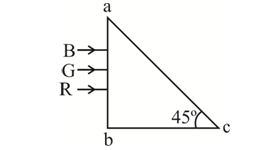
10.
A ray PQ is incident normally on the face AB of a triangular prism of refracting angle of 60º, made of a transparent material of refractive index \displaystyle 2/\sqrt{3}, as shown in the figure. Trace the path of the ray as it passed through the prism. Also calculate the angle of emergence and angle of deviation.

